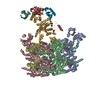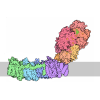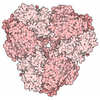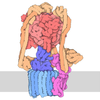[English] 日本語
 Yorodumi
Yorodumi- PDB-8dat: Saccharomyces cerevisiae Ufd1/Npl4/Cdc48 complex bound to three u... -
+ Open data
Open data
- Basic information
Basic information
| Entry | Database: PDB / ID: 8dat | |||||||||
|---|---|---|---|---|---|---|---|---|---|---|
| Title | Saccharomyces cerevisiae Ufd1/Npl4/Cdc48 complex bound to three ubiquitin moieties in presence of SUMO-ubiquitin(K48polyUb)-mEOS and ATP, state 1 (intB) | |||||||||
 Components Components |
| |||||||||
 Keywords Keywords | MOTOR PROTEIN / ATPASE / ATPASE COMPLEX / UBIQUITIN / SUMO / SMT3 / QUALITY CONTROL | |||||||||
| Function / homology |  Function and homology information Function and homology informationJosephin domain DUBs / RAS processing / Regulation of PTEN localization / ER Quality Control Compartment (ERQC) / UCH proteinases / Interleukin-1 signaling / Aggrephagy / Pexophagy / PINK1-PRKN Mediated Mitophagy / Regulation of pyruvate metabolism ...Josephin domain DUBs / RAS processing / Regulation of PTEN localization / ER Quality Control Compartment (ERQC) / UCH proteinases / Interleukin-1 signaling / Aggrephagy / Pexophagy / PINK1-PRKN Mediated Mitophagy / Regulation of pyruvate metabolism / SCF complex disassembly in response to cadmium stress / mitotic DNA replication termination / Ovarian tumor domain proteases / Cdc48p-Npl4p-Vms1p AAA ATPase complex / Doa10p ubiquitin ligase complex / stress-induced homeostatically regulated protein degradation pathway / Peroxisomal protein import / Synthesis of active ubiquitin: roles of E1 and E2 enzymes / endoplasmic reticulum membrane fusion / protein localization to vacuole / sister chromatid biorientation / Hrd1p ubiquitin ligase ERAD-L complex / ribophagy / DNA replication termination / RQC complex / Metalloprotease DUBs / Endosomal Sorting Complex Required For Transport (ESCRT) / mitochondria-associated ubiquitin-dependent protein catabolic process / positive regulation of mitochondrial fusion / cytoplasm protein quality control by the ubiquitin-proteasome system / HSF1 activation / nuclear protein quality control by the ubiquitin-proteasome system / protein-containing complex disassembly / E3 ubiquitin ligases ubiquitinate target proteins / protein transport to vacuole involved in ubiquitin-dependent protein catabolic process via the multivesicular body sorting pathway / endosome to plasma membrane protein transport / Translesion synthesis by REV1 / Translesion synthesis by POLK / Translesion synthesis by POLI / protein phosphatase regulator activity / Translesion Synthesis by POLH / piecemeal microautophagy of the nucleus / Termination of translesion DNA synthesis / Negative regulators of DDX58/IFIH1 signaling / mating projection tip / Recruitment and ATM-mediated phosphorylation of repair and signaling proteins at DNA double strand breaks / mitotic spindle disassembly / Protein methylation / VCP-NPL4-UFD1 AAA ATPase complex / replisome / vesicle-fusing ATPase / ribosome-associated ubiquitin-dependent protein catabolic process / K48-linked polyubiquitin modification-dependent protein binding / retrograde protein transport, ER to cytosol / nuclear outer membrane-endoplasmic reticulum membrane network / nonfunctional rRNA decay / Ubiquitin-Mediated Degradation of Phosphorylated Cdc25A / Regulation of PTEN stability and activity / CDK-mediated phosphorylation and removal of Cdc6 / FBXL7 down-regulates AURKA during mitotic entry and in early mitosis / KEAP1-NFE2L2 pathway / Neddylation / Formation of TC-NER Pre-Incision Complex / Orc1 removal from chromatin / MAPK6/MAPK4 signaling / SRP-dependent cotranslational protein targeting to membrane / GTP hydrolysis and joining of the 60S ribosomal subunit / Gap-filling DNA repair synthesis and ligation in TC-NER / Nonsense Mediated Decay (NMD) independent of the Exon Junction Complex (EJC) / Nonsense Mediated Decay (NMD) enhanced by the Exon Junction Complex (EJC) / Formation of a pool of free 40S subunits / protein quality control for misfolded or incompletely synthesized proteins / L13a-mediated translational silencing of Ceruloplasmin expression / Antigen processing: Ubiquitination & Proteasome degradation / Dual incision in TC-NER / polyubiquitin modification-dependent protein binding / autophagosome maturation / mRNA transport / Ub-specific processing proteases / ATP metabolic process / ERAD pathway / Neutrophil degranulation / rescue of stalled ribosome / ubiquitin binding / macroautophagy / modification-dependent protein catabolic process / positive regulation of protein localization to nucleus / protein tag activity / peroxisome / ubiquitin-dependent protein catabolic process / nuclear membrane / proteasome-mediated ubiquitin-dependent protein catabolic process / protein ubiquitination / ubiquitin protein ligase binding / endoplasmic reticulum membrane / perinuclear region of cytoplasm / ATP hydrolysis activity / mitochondrion / ATP binding / identical protein binding Similarity search - Function | |||||||||
| Biological species |  | |||||||||
| Method | ELECTRON MICROSCOPY / single particle reconstruction / cryo EM / Resolution: 3.8 Å | |||||||||
 Authors Authors | Lee, H.G. / Lima, C.D. | |||||||||
| Funding support |  United States, 2items United States, 2items
| |||||||||
 Citation Citation |  Journal: Proc Natl Acad Sci U S A / Year: 2023 Journal: Proc Natl Acad Sci U S A / Year: 2023Title: SUMO enhances unfolding of SUMO-polyubiquitin-modified substrates by the Ufd1/Npl4/Cdc48 complex. Authors: Hyein G Lee / Abigail A Lemmon / Christopher D Lima /  Abstract: The Ufd1/Npl4/Cdc48 complex is a universal protein segregase that plays key roles in eukaryotic cellular processes. Its functions orchestrating the clearance or removal of polyubiquitylated targets ...The Ufd1/Npl4/Cdc48 complex is a universal protein segregase that plays key roles in eukaryotic cellular processes. Its functions orchestrating the clearance or removal of polyubiquitylated targets are established; however, prior studies suggest that the complex also targets substrates modified by the ubiquitin-like protein SUMO. Here, we show that interactions between Ufd1 and SUMO enhance unfolding of substrates modified by SUMO-polyubiquitin hybrid chains by the budding yeast Ufd1/Npl4/Cdc48 complex compared to substrates modified by polyubiquitin chains, a difference that is accentuated when the complex has a choice between these substrates. Incubating Ufd1/Npl4/Cdc48 with a substrate modified by a SUMO-polyubiquitin hybrid chain produced a series of single-particle cryo-EM structures that reveal features of interactions between Ufd1/Npl4/Cdc48 and ubiquitin prior to and during unfolding of ubiquitin. These results are consistent with cellular functions for SUMO and ubiquitin modifications and support a physical model wherein Ufd1/Npl4/Cdc48, SUMO, and ubiquitin conjugation pathways converge to promote clearance of proteins modified with SUMO and polyubiquitin. | |||||||||
| History |
|
- Structure visualization
Structure visualization
| Structure viewer | Molecule:  Molmil Molmil Jmol/JSmol Jmol/JSmol |
|---|
- Downloads & links
Downloads & links
- Download
Download
| PDBx/mmCIF format |  8dat.cif.gz 8dat.cif.gz | 785.9 KB | Display |  PDBx/mmCIF format PDBx/mmCIF format |
|---|---|---|---|---|
| PDB format |  pdb8dat.ent.gz pdb8dat.ent.gz | 629.7 KB | Display |  PDB format PDB format |
| PDBx/mmJSON format |  8dat.json.gz 8dat.json.gz | Tree view |  PDBx/mmJSON format PDBx/mmJSON format | |
| Others |  Other downloads Other downloads |
-Validation report
| Summary document |  8dat_validation.pdf.gz 8dat_validation.pdf.gz | 2 MB | Display |  wwPDB validaton report wwPDB validaton report |
|---|---|---|---|---|
| Full document |  8dat_full_validation.pdf.gz 8dat_full_validation.pdf.gz | 2.1 MB | Display | |
| Data in XML |  8dat_validation.xml.gz 8dat_validation.xml.gz | 125.4 KB | Display | |
| Data in CIF |  8dat_validation.cif.gz 8dat_validation.cif.gz | 187.6 KB | Display | |
| Arichive directory |  https://data.pdbj.org/pub/pdb/validation_reports/da/8dat https://data.pdbj.org/pub/pdb/validation_reports/da/8dat ftp://data.pdbj.org/pub/pdb/validation_reports/da/8dat ftp://data.pdbj.org/pub/pdb/validation_reports/da/8dat | HTTPS FTP |
-Related structure data
| Related structure data |  27275MC  8darC  8dasC  8dauC  8davC  8dawC M: map data used to model this data C: citing same article ( |
|---|---|
| Similar structure data | Similarity search - Function & homology  F&H Search F&H Search |
- Links
Links
- Assembly
Assembly
| Deposited unit | 
|
|---|---|
| 1 |
|
- Components
Components
-Protein , 4 types, 11 molecules ABCDEFGHJKL
| #1: Protein | Mass: 92389.195 Da / Num. of mol.: 6 Source method: isolated from a genetically manipulated source Source: (gene. exp.)  Gene: CDC48, YDL126C / Production host:  #2: Protein | | Mass: 66144.336 Da / Num. of mol.: 1 Source method: isolated from a genetically manipulated source Source: (gene. exp.)  Gene: NPL4, HRD4, YBR170C, YBR1231 / Production host:  #3: Protein | | Mass: 40001.449 Da / Num. of mol.: 1 Source method: isolated from a genetically manipulated source Source: (gene. exp.)  Gene: UFD1, PIP3, YGR048W / Production host:  #4: Protein | Mass: 8568.769 Da / Num. of mol.: 3 Source method: isolated from a genetically manipulated source Details: ubiquitin that is part of the SUMO-ubiquitin(K48polyUb)-mEOS substrate; SUMO-ubiquitin-mEOS modified on K48 of ubiquitin with a K48-linked polyubiquitin. Sequence of the unmodified substrate ...Details: ubiquitin that is part of the SUMO-ubiquitin(K48polyUb)-mEOS substrate; SUMO-ubiquitin-mEOS modified on K48 of ubiquitin with a K48-linked polyubiquitin. Sequence of the unmodified substrate is MGSSHHHHHHSSGENLYFQGHMSDSEVNQEAKPEVKPEVKPETHINLKVSDGSSEIFFKIKKTTPLRRLMEAFAKRQGKEMDSLRFLYDGIRIQADQTPEDLDMEDNDIIEAHREQIGGSHMQIFVKTLTGKTITLEVESSDTIDNVKSKIQDKEGIPPDQQRLIFAGKQLEDGRTLSDYNIQKESTLHLVLRLRGGMSAIKPDMKIKLRMEGNVNGHHFVIDGDGTGKPFEGKQSMDLEVKEGGPLPFAFDILTTAFHYGNRVFAKYPDNIQDYFKQSFPKGYSWERSLTFEDGGICNARNDITMEGDTFYNKVRFYGTNFPANGPVMQKKTLKWEPSTEKMYVRDGVLTGDIEMALLLEGNAHYRCDFRTTYKAKEKGVKLPGAHFVDHCIEILSHDKDYNKVKLYEHAVAHSGLPDNARR Source: (gene. exp.)  Gene: UBI4, SCD2, YLL039C / Production host:  |
|---|
-Non-polymers , 3 types, 14 molecules 




| #5: Chemical | ChemComp-ATP / #6: Chemical | ChemComp-ADP / #7: Chemical | |
|---|
-Details
| Has ligand of interest | N |
|---|---|
| Has protein modification | Y |
-Experimental details
-Experiment
| Experiment | Method: ELECTRON MICROSCOPY |
|---|---|
| EM experiment | Aggregation state: PARTICLE / 3D reconstruction method: single particle reconstruction |
- Sample preparation
Sample preparation
| Component |
|
|---|
 Movie
Movie Controller
Controller







 PDBj
PDBj



















 gel filtration
gel filtration

